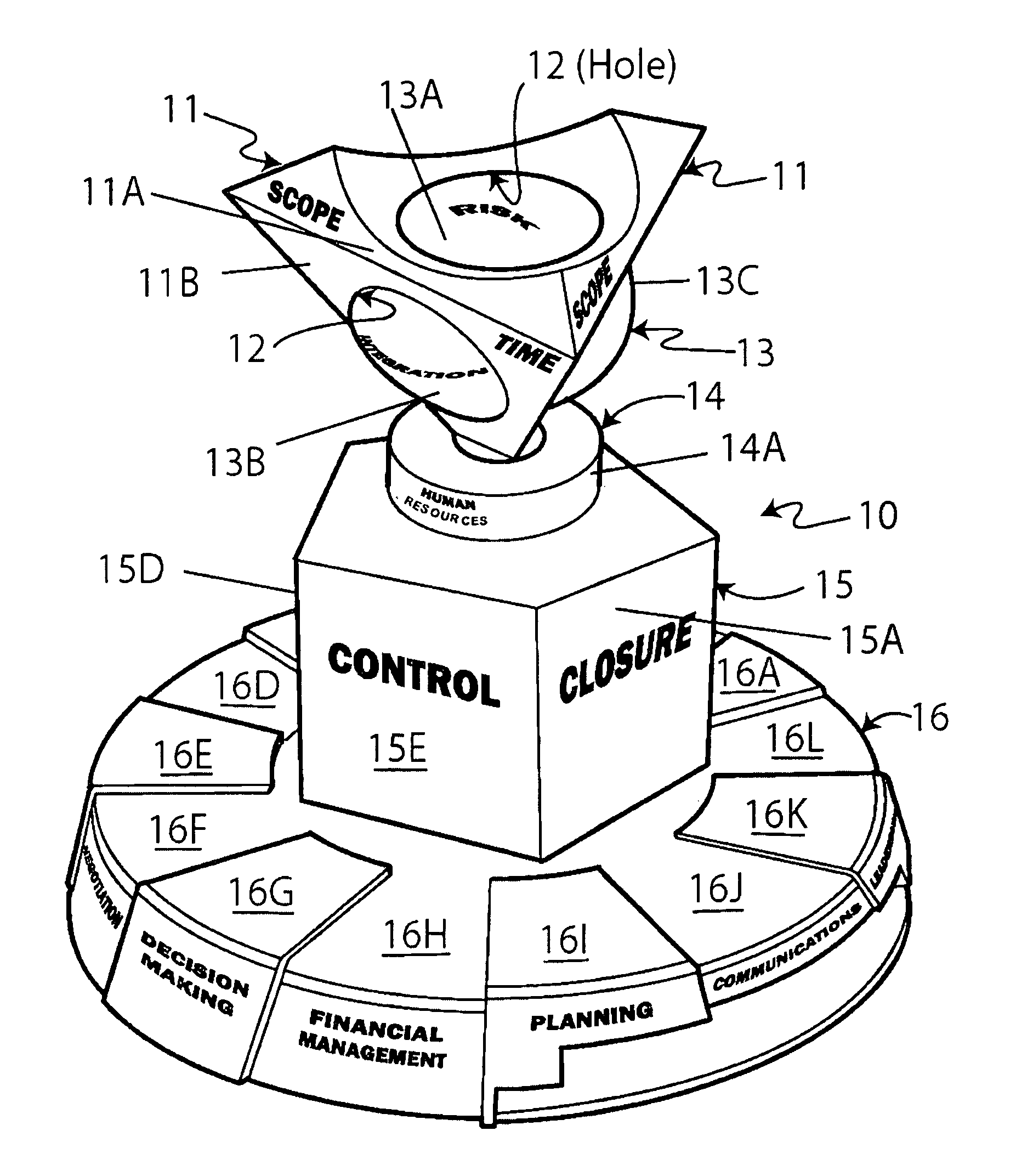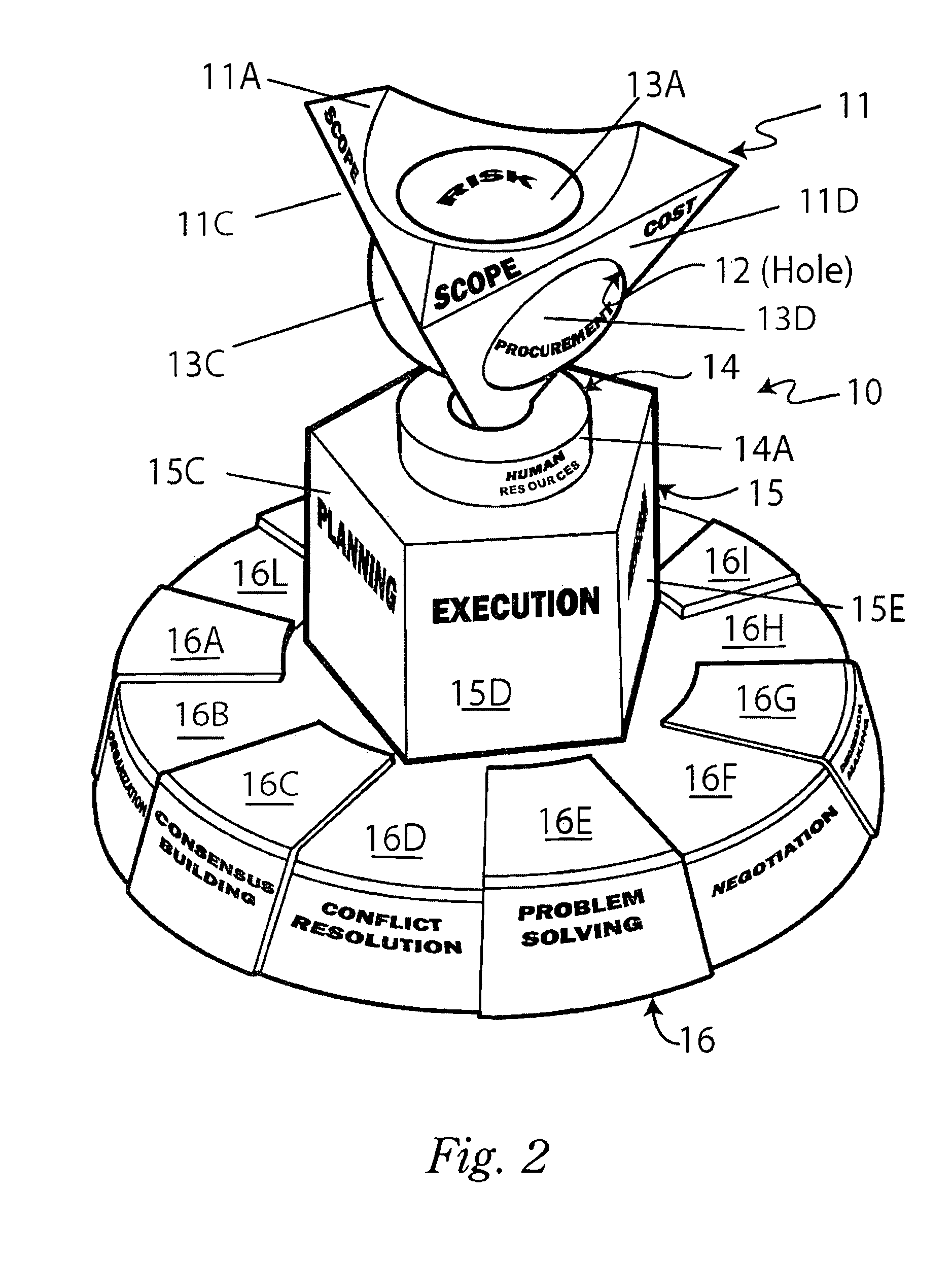Method and system for arranging and displaying project management intelligence
a project management and intelligence technology, applied in the field of systems for displaying and communicating various aspects of project management, can solve the problems of large quantities of other critical project intelligence knowledge, large quantities of essential project knowledge, and large quantities of managerial competency functions and elements necessary for successful project management, and achieves rapid order, reliability and uniformity, and superior communication repeatability. , the effect of fast and easy form and access
- Summary
- Abstract
- Description
- Claims
- Application Information
AI Technical Summary
Benefits of technology
Problems solved by technology
Method used
Image
Examples
example 1
[0054]In one example, as shown schematically in FIG. 3, the uppermost polytope 11, the spherical polytope 13, the collar 14, the intermediate polytope 15, and the lowermost polytope 16, each bearing at least one information item per polytope; may be arranged to display: SCOPE-TIME, INTEGRATION, HUMAN RESOURCES, PLANNING, and LEADERSHIP. In this example spatially aligned exhibit; scope-time core knowledge, integration facilitating knowledge, human resources facilitating knowledge and the planning process group are aligned with the leadership management skill. The FIG. 3, spatially aligned project management exhibit displays an ordered project intelligence image and the ordered display's perspective may be spatially maintained in relation to, and concurrent with, all other aspects of project management (and remain so until the target desires an alternate exhibit of another preferred example exhibit showing a different spatially conjoined and interrelated display of a separate aligned ...
example 2
[0055]In a second separate example, as shown schematically in FIG. 4, the uppermost polytope 11, the spherical polytope 13, the collar 14, the intermediate polytope 15, and the lowermost polytope 16, each bearing at least one information item per polytope; may be arranged to display: SCOPE-COST, INTEGRATION, HUMAN RESOURCES, PLANNING, and NEGOTIATION.
[0056]Still other spatially arranged and aligned exhibits of project management image patterns may be formed from hundreds of thousands of separate distinct combinations of uniquely related project management functions by arranging the plurality of polytopes, plurality of polytope sections, and plurality of information items forming combined alignment exhibits having at least one information item, one polytope section and one polytope, all of which are directed toward characteristics related to a specific conjoined display of one interrelated perspective of the field of project management intelligence. Those skilled in the art will unde...
example 3
[0057]The plurality of polytopes, and plurality of polytope sections, may also be arranged with respect to adjacent multiple pluralities of information items thereby forming multiple but distinct combinatorial aligned image patterns exhibiting multiple elements within a domain depicted within the display. For example, as shown schematically in FIG. 5, the uppermost polytope 11, the spherical polytope segments 13, the collar 14, the intermediate polytope 15, and the lowermost polytope 16, may be arranged to display: SCOPE-TIME, SCOPE-COST, INTEGRATION—PROCUREMENT-HUMAN RESOURCES and INITIATION-PLANNING-EXECUTION and PLANNING-COMMUNICATIONS-LEADERSHIP-TIME MANAGEMENT-TEAM DEVELOPMENT.
[0058]The number of spatially aligned images in the broad sample space of all possible spatial images considered without regard to unique ordering is so great that efficient methods are needed to count the total number of discrete alignment images. In order to determine the possible number of distinct ali...
PUM
 Login to View More
Login to View More Abstract
Description
Claims
Application Information
 Login to View More
Login to View More - R&D
- Intellectual Property
- Life Sciences
- Materials
- Tech Scout
- Unparalleled Data Quality
- Higher Quality Content
- 60% Fewer Hallucinations
Browse by: Latest US Patents, China's latest patents, Technical Efficacy Thesaurus, Application Domain, Technology Topic, Popular Technical Reports.
© 2025 PatSnap. All rights reserved.Legal|Privacy policy|Modern Slavery Act Transparency Statement|Sitemap|About US| Contact US: help@patsnap.com



